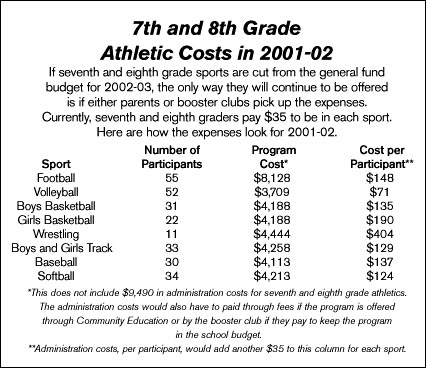Extracurriculars may change, not disappear
 A year ago, a number of extracurricular activities were proposed for cuts, but saved by the school board. This year, a number of these activities are back on the chopping block, and to survive they may need to find alternative financing.
A year ago, a number of extracurricular activities were proposed for cuts, but saved by the school board. This year, a number of these activities are back on the chopping block, and to survive they may need to find alternative financing. Extracurricular activities being considered as budget reductions include seventh and eighth grade athletics ($39,710), marching band ($9,500), cheerleading ($5,230), middle and high school speech ($4,882), school plays ($4,250), danceline ($3,240), knowledge bowl ($2,089), middle school FLA ($1,207), pops choir ($886), and jazz band ($886).
Having sports pay for any state tournament costs was mentioned as a potential future cut, but not formally proposed.
While the school board - in meeting first on Tuesday, Jan. 22, and then on Monday, Jan. 28 - discussed junior high athletics at length, the pattern for survival for all these activities, if they get cut from the general budget, will depend on securing financing from outside the school district.
That could happen in at least two ways, according to board discussions with school administration.
First, the program could be offered in an alternative form by Community Education. All programs by Community Education, though, have to be self-supporting, including administrative costs.
Or, the program could continue in the general fund budget but only if sponsored by outside funding. The most likely survivors through this scenario would be seventh and eighth grade athletics, which are tremendously important to their high school counterparts.
Since most sports already have booster clubs in place, they would seem logical candidates to fund a junior high program.
Board chairman Pat Flanders explained this as a variation of the sports clubs used in Europe, which do not have organized, competitive sports in schools. Each sports' booster club would have the opportunity to fund its junior high program, based on how much money the club raised. If the booster club raised enough and wanted to continue the existing program, they would be able to do so.
"Is it a fix or cure?" asked Flanders. "No. I would rather have the old programs back."
"Like it or not," he added, "we're going to see more booster clubs and more fund raisers."
An advantage for booster clubs opting to run a program through Community Education, noted Matt Dickhausen, is having a better control on costs. Programs through the general fund come under the master agreement that stipulates the salary for the coach. "Right now, we pay our seventh and eighth grade coaches very well, more than our varsity coaches if you break it down on a per hour basis," he said.
Booster clubs could line up volunteer coaches, or pay smaller salaries, if they ran the programs through Community Education. They also could opt to have parents drive, rather than have the school provide transportation.
In many ways, these programs would be similar to hockey, whose association runs its own youth programs but has varsity hockey through the school, with the association and players paying for all expenses.
If a booster club was inactive, Community Education would still try to have a sports program in place at the junior high level, but it would not be what is presently offered, said Dickhausen. It would also be dependent on participation numbers, and fees, to cover the costs, including administration.
More of the costs of these sports, and possibly other extracurricular activities, could be shifted home. Board member Mark Dingmann predicted last week, "You're going to pay for it with your kids."
Contact the author at paypress@lkdllink.net • Return to News Menu
Home | Marketplace | Community